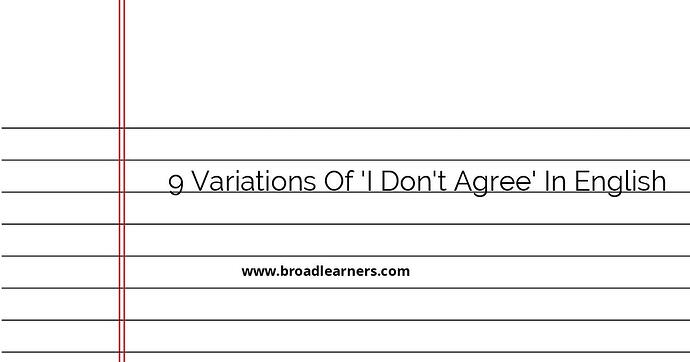When you want to express disagreement in English, saying 'I don't agree' is a simple and straightforward phrase. However, there are several alternative ways to convey this sentiment, depending on the situation and level of formality. Here are nine variations of 'I don't agree' in English:
- I disagree
- That's not how I see it
- I have a different opinion
- I'm sorry, but I can't agree
- That's not my understanding
- I beg to differ
- I'm afraid I have to disagree
- I'm not convinced
- I respectfully disagree
Now let's look at each variation in more detail:
1. I disagree
'I disagree' is a simple and direct way to express your disagreement. It is clear and to the point, making it suitable for both formal and informal situations.
Example: Sarah: 'I think we should cancel the event.' Alex: 'I disagree. I believe we can find a solution to the problem.'
2. That's not how I see it
Using the phrase 'That's not how I see it' allows you to express your different perspective without directly contradicting the other person. It shows that you have a different viewpoint without dismissing theirs entirely.
Example: John: 'I think we should focus on expanding our product line.' Mary: 'That's not how I see it. I believe we should improve our current products before expanding.'
3. I have a different opinion
'I have a different opinion' is a polite way to disagree with someone. It acknowledges their viewpoint while asserting your own perspective.
Example: Tom: 'I think we should invest more in digital marketing.' Emily: 'I respect your opinion, but I have a different opinion. I believe traditional marketing still has value.'
4. I'm sorry, but I can't agree
'I'm sorry, but I can't agree' conveys a sense of politeness while still asserting your disagreement. It shows that you acknowledge the other person's perspective but cannot align with it.
Example: David: 'I think we should hire more employees.' Lisa: 'I'm sorry, but I can't agree. I believe we should focus on optimizing our current workforce.'
5. That's not my understanding
'That's not my understanding' implies that the information or explanation provided is different from what you know or believe. It allows you to express your disagreement by questioning the accuracy of the other person's statement.
Example: Michael: 'The project deadline is next week.' Sarah: 'That's not my understanding. Based on the timeline I received, the deadline is in two weeks.'
6. I beg to differ
'I beg to differ' is a slightly more formal way to express your disagreement. It suggests that you have a strong conviction in your opposing viewpoint.
Example: Emma: 'I think we should prioritize cost-cutting measures.' James: 'I beg to differ. I believe investing in quality will lead to long-term savings.'
7. I'm afraid I have to disagree
'I'm afraid I have to disagree' adds a polite and apologetic tone to your disagreement. It conveys that you feel compelled to express your differing opinion despite potential discomfort.
Example: Sarah: 'I think we should choose Option A.' John: 'I'm afraid I have to disagree. Option B seems more practical and cost-effective.'
8. I'm not convinced
'I'm not convinced' suggests that you have reservations or doubts about the other person's viewpoint. It indicates a need for further convincing or evidence.
Example: Alex: 'I think we should invest in this new technology.' Sarah: 'I'm not convinced. We need more data on its potential benefits and drawbacks.'
9. I respectfully disagree
'I respectfully disagree' incorporates a respectful tone into your disagreement. It shows that you value the other person's opinion while maintaining your own stance.
Example: John: 'I believe we should focus on expanding our customer base.' Mary: 'I respectfully disagree. I think improving customer retention should be our priority.'
Using these alternative phrases can help you express your disagreement in different contexts and maintain a respectful and constructive conversation. Remember to consider the tone of the conversation and the relationship with the person you are disagreeing with when choosing the appropriate variation.
Did I miss anything? Respond below
